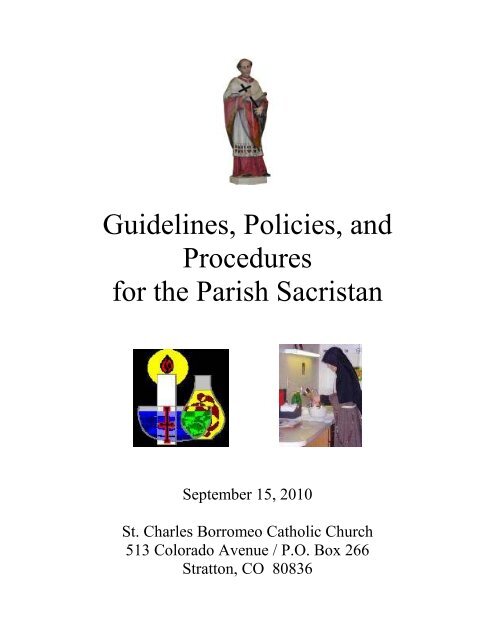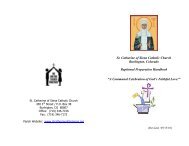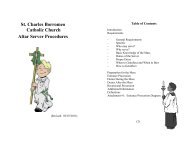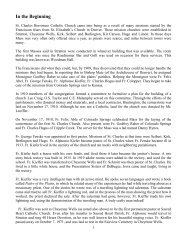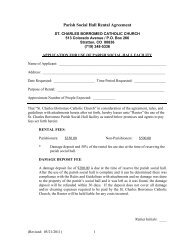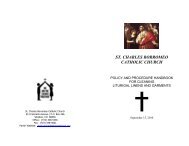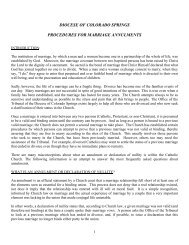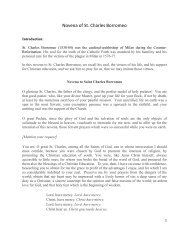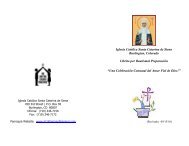Guidelines, Policies, and Procedures for the Parish Sacristan
Guidelines, Policies, and Procedures for the Parish Sacristan
Guidelines, Policies, and Procedures for the Parish Sacristan
You also want an ePaper? Increase the reach of your titles
YUMPU automatically turns print PDFs into web optimized ePapers that Google loves.
<strong>Guidelines</strong>, <strong>Policies</strong>, <strong>and</strong><br />
<strong>Procedures</strong><br />
<strong>for</strong> <strong>the</strong> <strong>Parish</strong> <strong>Sacristan</strong><br />
September 15, 2010<br />
St. Charles Borromeo Catholic Church<br />
513 Colorado Avenue / P.O. Box 266<br />
Stratton, CO 80836
September 15, 2010<br />
Dear Bro<strong>the</strong>rs <strong>and</strong> Sisters in Christ,<br />
Please accept my congratulations <strong>and</strong> sincere gratitude <strong>for</strong> your decision to assist <strong>the</strong> St.<br />
Charles Borromeo Catholic Church <strong>and</strong> parish community by volunteering your time,<br />
talent, <strong>and</strong> skills to <strong>the</strong> <strong>Sacristan</strong> Ministry.<br />
As you will soon read in <strong>the</strong> attached parish-level h<strong>and</strong>out, concerning our established<br />
<strong>Sacristan</strong> Ministry Program, it is a vibrant, worthwhile, <strong>and</strong> tremendous ministry that<br />
directly affects <strong>the</strong> quality of our daily community’s liturgical celebrations.<br />
Please know that I am available to assist you <strong>and</strong> answer any questions you may have or<br />
receive your comments/suggestions.<br />
May God bless you abundantly in this ministry at <strong>the</strong> service of Our Lord <strong>and</strong> His People.<br />
Respectfully<br />
Yours in Christ,<br />
Fr. R.G. Newbury Jr.<br />
Pastor<br />
2
TABLE OF CONTENTS<br />
General In<strong>for</strong>mation . . . . . . . . . . . . . . . . . . . . . . . . 4<br />
Church History . . . . . . . . . . . . . . . . . . . . . . . . 4<br />
Role of <strong>the</strong> <strong>Sacristan</strong> . . . . . . . . . . . . . . . . . . . . . . . . 4<br />
Desired Qualities / Qualifications of a <strong>Parish</strong> <strong>Sacristan</strong> 4<br />
<strong>Sacristan</strong> <strong>Guidelines</strong> . . . . . . . . . . . . . . . . . . . . . . . . 5-7<br />
Closing Comments . . . . . . . . . . . . . . . . . . . . . . . . 7<br />
References . . . . . . . . . . . . . . . . . . . . . . . . 7<br />
Attachment #1<br />
<strong>Sacristan</strong> Duties Checklist . . . . . . . . . . . . . . . . . . 8-10<br />
Attachment #2<br />
Norms/<strong>Guidelines</strong> Regarding Cleaning Liturgical<br />
Clo<strong>the</strong>s/Garments . . . . . . . . . . . . . . . . . . . . . . . . 11-13<br />
3
General In<strong>for</strong>mation: By definition (Merriam-Webster Dictionary), a “<strong>Sacristan</strong>” is<br />
defined as “a person in charge of <strong>the</strong> sacristy <strong>and</strong> church-related ceremonial equipment”.<br />
A sacristy is a room <strong>for</strong> keeping liturgical vestments (such as <strong>the</strong> priests’ cassocks, albs,<br />
stoles <strong>and</strong> chasubles; <strong>and</strong> <strong>the</strong> deacons’ albs, stoles, <strong>and</strong> dalmatics) <strong>and</strong> o<strong>the</strong>r church<br />
furnishings, sacred vessels, <strong>and</strong> ritual books. The sacristy is generally off-limits except<br />
<strong>for</strong>: <strong>the</strong> clergy; scheduled sacristan; <strong>and</strong> those assisting with set-up <strong>for</strong> <strong>the</strong> Liturgy.<br />
Using <strong>the</strong> sacristy as a location <strong>for</strong> parishioner’s to store personal property (e.g., coats,<br />
purses, etc) is strongly discouraged; as it detracts from its principal purpose. Such things<br />
are better left in our vehicles <strong>and</strong> <strong>the</strong>re<strong>for</strong>e, does not m<strong>and</strong>ate that <strong>the</strong> sacristy stay in or<br />
closely monitor <strong>the</strong> sacristy to safeguard <strong>the</strong>se personal property items of o<strong>the</strong>rs.<br />
Church History: In ancient times, many of <strong>the</strong> sacristan’s duties were per<strong>for</strong>med by <strong>the</strong><br />
doorkeepers. The Decretals of Pope Gregory IX speak of <strong>the</strong> sacristan as having an<br />
honorable office <strong>and</strong> that <strong>the</strong>ir principal duties were to care <strong>for</strong> <strong>the</strong> sacred vessels,<br />
vestments, etc. Presently, <strong>the</strong> sacristan is an appointed official in <strong>the</strong> parish. The<br />
"Cæremoniale Episcoporum" prescribed that in ca<strong>the</strong>dral <strong>and</strong> collegiate churches, <strong>the</strong><br />
sacristan should be a priest, <strong>and</strong> describes his duties in regard to <strong>the</strong> sacristy, <strong>the</strong> Blessed<br />
Sacrament, <strong>the</strong> baptismal font, <strong>the</strong> holy oils, <strong>the</strong> sacred relics, <strong>the</strong> decoration of <strong>the</strong><br />
church <strong>for</strong> <strong>the</strong> different seasons <strong>and</strong> feasts, <strong>the</strong> preparation of what is necessary <strong>for</strong> <strong>the</strong><br />
various ceremonies, <strong>the</strong> ringing of <strong>the</strong> church bells, <strong>the</strong> preservation of liturgical <strong>and</strong><br />
sacramental order in <strong>the</strong> church, <strong>and</strong> <strong>the</strong> distribution of Masses.<br />
The Role of <strong>the</strong> <strong>Sacristan</strong>: Our appreciation <strong>and</strong> underst<strong>and</strong>ing of <strong>the</strong> role of <strong>the</strong><br />
sacristan has developed h<strong>and</strong>-in-h<strong>and</strong> with our growing <strong>and</strong> underst<strong>and</strong>ing of <strong>the</strong><br />
teaching of <strong>the</strong> Second Vatican Council (SVC), that all members of <strong>the</strong> Church “should<br />
be led to take a full, conscious, active part in <strong>the</strong> liturgical celebrations which are<br />
dem<strong>and</strong>ed by <strong>the</strong> very nature of <strong>the</strong> liturgy” (Constitution of <strong>the</strong> Sacred Liturgy, 14). …<br />
<strong>the</strong> worship community needs ministers … one such minister is <strong>the</strong> sacristan.<br />
The ministry of <strong>the</strong> sacristan is a bit like <strong>the</strong> work of a weaver. In order <strong>for</strong> all <strong>the</strong><br />
members of a community of faith to take <strong>the</strong>ir full, conscious <strong>and</strong> active part in liturgical<br />
celebrations, <strong>the</strong>re needs to be someone who prepares <strong>and</strong> oversees <strong>the</strong> things of <strong>the</strong><br />
liturgy. … The sacristan is to know <strong>the</strong> meaning <strong>and</strong> purpose of <strong>the</strong> liturgy as well as <strong>the</strong><br />
needs of <strong>the</strong> particular liturgical assembly, <strong>and</strong> to work carefully to see <strong>the</strong> liturgy’s ends<br />
realized by providing <strong>the</strong> members of <strong>the</strong> assembly with <strong>the</strong> tools <strong>the</strong>y need [<strong>for</strong> a<br />
meaningful, prayerful, <strong>and</strong> active celebration].<br />
Since <strong>the</strong> SVC, more-<strong>and</strong>-more of <strong>the</strong>se previously priestly reserved sacristan<br />
responsibilities have been delegated to an appointed member of <strong>the</strong> laity. At <strong>the</strong> St.<br />
Charles Borromeo Catholic Church, we have an appointed lead sacristan <strong>and</strong> individual<br />
Mass sacristans who fulfill <strong>the</strong>se liturgical functions <strong>and</strong> duties.<br />
Desired Qualities/Qualifications of a <strong>Parish</strong> <strong>Sacristan</strong>:<br />
• Must be a baptized Catholic in good st<strong>and</strong>ing <strong>and</strong> a registered member of <strong>the</strong> St.<br />
Charles Borromeo parish community.<br />
4
• Has a basic knowledgeable <strong>and</strong> experience of liturgical rites (e.g., <strong>the</strong> Mass;<br />
Communion Service; Eucharistic Adoration; Baptism; Funerals; Reconciliation<br />
Service; etc.) <strong>and</strong> is aware of <strong>the</strong> dem<strong>and</strong>s of <strong>the</strong> liturgical position.<br />
• Underst<strong>and</strong>s how to use <strong>the</strong> ecclesiastical region’s published Ordo.<br />
• Willing to work with a variety of religious traditions <strong>and</strong> cultures.<br />
• Able to work, liaison, <strong>and</strong> communicate well with o<strong>the</strong>rs involved in:<br />
(a) liturgical planning <strong>and</strong> (b) liturgical practice.<br />
• Is a “team member” <strong>and</strong> a “team player”.<br />
• Is capable of being <strong>for</strong>mally commissioned, ideally during a Sunday Mass,<br />
utilizing a blessing taken from <strong>the</strong> Book of Blessings (Chapter 62, Order <strong>for</strong> <strong>the</strong><br />
Blessing of Altar Servers, <strong>Sacristan</strong>s, Musicians, <strong>and</strong> Ushers).<br />
• Able <strong>and</strong> willing to learn about liturgical principles <strong>and</strong> to put those principles<br />
into practice.<br />
• Self-motivated <strong>and</strong> possesses ability to follow-through.<br />
• Able to request needed repairs/replacement through <strong>the</strong> parish’s pastor or deacon.<br />
• Able to work on Sundays <strong>and</strong> is flexible (during <strong>the</strong> year, as needed) (e.g., Holy<br />
Week; Reconciliation Services; etc.)<br />
• Is able to find spiritual nourishment <strong>and</strong> enrichment within <strong>the</strong> ministry.<br />
<strong>Sacristan</strong> <strong>Guidelines</strong>: Overall, <strong>the</strong> role of <strong>the</strong> sacristan is to oversee <strong>and</strong> keep in good<br />
order <strong>the</strong> worship space (including <strong>the</strong> sanctuary, <strong>the</strong> nave, <strong>and</strong> <strong>the</strong> ga<strong>the</strong>ring area) <strong>and</strong><br />
<strong>the</strong> sacristy. They must have a reverence <strong>for</strong> <strong>the</strong> sanctuary <strong>and</strong> <strong>for</strong> all articles <strong>and</strong> sacred<br />
vessels used in worship <strong>and</strong> liturgical activities. The sacristan is <strong>the</strong> person who is<br />
appointed to be available to prepare everything needed <strong>for</strong> <strong>the</strong> liturgy. The tasks could<br />
include (but are not limited) to:<br />
• Make sure <strong>the</strong> furniture in <strong>the</strong> sanctuary is clean, appropriately positioned <strong>and</strong> not<br />
cluttered. This includes <strong>the</strong> altar, ambo, lectern, presider/deacon chair <strong>and</strong> o<strong>the</strong>r<br />
articles/furnishings in <strong>the</strong> sanctuary.<br />
• Work with <strong>the</strong> priests, deacons, liturgist, <strong>and</strong> o<strong>the</strong>r liturgical ministers.<br />
• (Lead sacristan) Serve as a member of <strong>the</strong> parish’s Liturgy Committee.<br />
• Be familiar with <strong>the</strong> Ordo, Sacramentary, Lectionary, <strong>and</strong> o<strong>the</strong>r ritual books<br />
needed in <strong>the</strong> liturgy <strong>and</strong> sets <strong>the</strong>m up properly in preparation <strong>for</strong> <strong>the</strong> planned<br />
liturgies.<br />
• Be responsible <strong>for</strong> <strong>the</strong> cleanliness of <strong>the</strong> sacristy.<br />
• Be responsible <strong>for</strong> <strong>the</strong> ordering (through <strong>the</strong> parish liturgist) of all supplies <strong>and</strong><br />
materials (e.g., unconsecrated/approved sacramental hosts <strong>and</strong> wine; c<strong>and</strong>les; altar<br />
linens; liquid wax; purificators; incense; charcoal; etc) required <strong>for</strong> liturgies.<br />
Note: This responsibility may be shared/sub-delegated to o<strong>the</strong>r<br />
individuals/groups (e.g., <strong>the</strong> <strong>Parish</strong>’s Altar/Rosary Society; etc.) with <strong>the</strong> pastor’s<br />
knowledge <strong>and</strong> approval.<br />
• Makes sure that processional c<strong>and</strong>les are clean <strong>and</strong> functional, with wicked<br />
trimmed, as needed.<br />
• Arrange <strong>the</strong> seating areas <strong>for</strong> <strong>the</strong> servers, deacon <strong>and</strong> celebrant; placing hymnals<br />
<strong>and</strong>/or binders (containing <strong>the</strong> Prayers of <strong>the</strong> Faithful <strong>and</strong> announcements) at <strong>the</strong>ir<br />
seats.<br />
5
• If incense is to be used, fill <strong>the</strong> boat with incense, place charcoal in <strong>the</strong> thurible or<br />
bowl, <strong>and</strong> light <strong>the</strong> charcoal approximately 15 minutes prior to <strong>the</strong> start of <strong>the</strong><br />
procession; place <strong>the</strong> st<strong>and</strong> or pedestal <strong>for</strong> <strong>the</strong> thurible <strong>and</strong> boat in <strong>the</strong> desired<br />
location.<br />
• Order supplies needed <strong>for</strong> liturgies (e.g., approved sacramental wine, hosts,<br />
c<strong>and</strong>les, vestments, altar linens, etc.). As noted above, this may be shared/subdelegated<br />
with <strong>the</strong> pastor’s knowledge <strong>and</strong> approval.<br />
• Ensure sufficient amount of clean purificators, corporals, h<strong>and</strong> towels, incense,<br />
<strong>and</strong> charcoals are available <strong>for</strong> <strong>the</strong> week’s liturgies.<br />
• Be responsible <strong>for</strong> promptly in<strong>for</strong>ming <strong>the</strong> pastor or <strong>the</strong> parish’s deacon of any<br />
liturgical device (chair, book, etc) which is in need of repair or replacement.<br />
• Serve as a member of <strong>the</strong> parish’s environment committee to plan <strong>the</strong> decorations<br />
needed <strong>for</strong> <strong>the</strong> different liturgical seasons <strong>and</strong> help with <strong>the</strong> decoration; to Ensure<br />
compliance with published church norms.<br />
• Arrange <strong>the</strong> liturgical book(s) needed <strong>for</strong> <strong>the</strong> celebration, marking all of <strong>the</strong><br />
divisions/sections.<br />
• Lay out <strong>the</strong> vestments <strong>and</strong>/or anything else needed <strong>for</strong> <strong>the</strong> celebration (such as<br />
cruets, chalices, ciboria, linens, oils, processional crosses, c<strong>and</strong>les, etc).<br />
• Ensure <strong>the</strong> church’s bells are rung to announce <strong>the</strong> celebrations to <strong>the</strong> local<br />
community at least 5 minutes be<strong>for</strong>e <strong>the</strong> liturgy begins.<br />
• (The lead sacristan (along with <strong>the</strong> parish’s liturgist)) Be responsible <strong>for</strong> insuring<br />
that those who wash <strong>the</strong> altar linens do so according to <strong>the</strong> church’s published<br />
liturgical norms. (See Attachment #2 <strong>for</strong> norms/guidelines regarding cleaning of<br />
liturgical clo<strong>the</strong>s <strong>and</strong> garments.)<br />
• (The lead sacristan (along with <strong>the</strong> parish’s liturgist)) Be responsible <strong>for</strong> insuring<br />
that those who cleanse <strong>the</strong> sacred vessels after communion do so according to <strong>the</strong><br />
church’s published liturgical norms. (See Attachment #2 <strong>for</strong> norms/guidelines<br />
regarding cleaning of sacred vessels.)<br />
• (The lead sacristan (along with <strong>the</strong> parish’s liturgist)) Take care to burn or bury<br />
old linens <strong>and</strong> o<strong>the</strong>r objects (as appropriate) that are no longer suitable <strong>for</strong><br />
liturgical use.<br />
• Ensure that <strong>the</strong> sanctuary vigil lamp is always burning; <strong>and</strong> is replaced if/as<br />
needed weekly.<br />
• Ensure that <strong>the</strong> holy water stoups are cleaned <strong>and</strong> replenished, as needed.<br />
• Ensure that <strong>the</strong> holy water font is cleaned <strong>and</strong> replenished, as needed. Note: If<br />
new (unblessed) water is added to <strong>the</strong> font, will contact a priest or deacon to bless<br />
<strong>the</strong> water, as soon as possible.<br />
• If <strong>the</strong>re is a sprinkling rite, Ensure <strong>the</strong> water bucket <strong>and</strong> sprinkler are prepared <strong>and</strong><br />
placed on <strong>the</strong> credence table <strong>for</strong> use during <strong>the</strong> Mass.<br />
• Ensure any pyxes containing communion hosts (<strong>for</strong> distribution to <strong>the</strong><br />
homebound, hospitalized, etc) (to be consecrated during <strong>the</strong> Mass) are placed on<br />
<strong>the</strong> credence table <strong>and</strong> brought to/placed on <strong>the</strong> altar during <strong>the</strong> Preparation of <strong>the</strong><br />
Gifts.<br />
6
There should be an adequate annual parish budget allocated <strong>for</strong> <strong>the</strong> <strong>Sacristan</strong> Ministry.<br />
This budget is usually under liturgy expenses <strong>and</strong> is <strong>the</strong> responsibility of <strong>the</strong> parish’s<br />
appointed liturgist.<br />
Sacristies usually contain a special wash basin, called a Sacrarium, in which <strong>the</strong> drain<br />
flows directly into <strong>the</strong> ground to prevent sacred material (such as used baptismal water)<br />
from being washed into <strong>the</strong> common sewers or septic tanks. At <strong>the</strong> St. Charles<br />
Borromeo Catholic Church, <strong>the</strong> sacrarium is located in <strong>the</strong> sacristy. <strong>Sacristan</strong>s must be<br />
alert NOT to utilize <strong>the</strong> sacristy sink to dispose of liquids or materials which need to be<br />
poured down <strong>the</strong> designated sacrarium. The sacrarium is used to wash linens used during<br />
<strong>the</strong> celebration of <strong>the</strong> Mass <strong>and</strong> purificators used during Holy Communion.<br />
At <strong>the</strong> St. Charles Borromeo Catholic Church, <strong>the</strong> cruets, chalices, ciborium, <strong>and</strong> patens<br />
are stored in cabinets located behind <strong>the</strong> altar. Clean <strong>and</strong> soiled altar linens are generally<br />
stored in <strong>the</strong> sacristy. The Sacristy is generally off-limits to <strong>the</strong> general public.<br />
Closing Comments: In <strong>the</strong> event <strong>the</strong>re is conflicting in<strong>for</strong>mation or instruction, between<br />
that provided by <strong>the</strong> parish’s liturgist <strong>and</strong> those clergy associated with a planned liturgy,<br />
<strong>the</strong> instructions or requests of <strong>the</strong> clergy will take precedence over <strong>the</strong> liturgist’s<br />
decisions in all such instances. In o<strong>the</strong>r words, <strong>the</strong> presider (priest or deacon) has <strong>the</strong> last<br />
word in such liturgical matters.<br />
References<br />
Ave Maria Catholic Church, <strong>Sacristan</strong> Duties Checklist, undated, Parker, CO.<br />
Neff, Christina, Guide <strong>for</strong> <strong>Sacristan</strong>s, @2001, Liturgy Training Publications, Chicago, IL.<br />
USCCB, General Instruction to <strong>the</strong> Roman Missal (GIRM), @2002, Washington, DC.<br />
Zenit, A <strong>Sacristan</strong>’s Duties, Vatican News Article, 8/21/07, Rome, Italy.<br />
7
Attachment #1<br />
(Norms/guidelines regarding cleaning of liturgical clo<strong>the</strong>s/garments)<br />
The Care <strong>and</strong> Cleansing of Altar Linens,<br />
Purification <strong>and</strong> Cleansing of Communion<br />
Vessels <strong>and</strong> Use of <strong>the</strong> Sacrarium<br />
The following guidance is from <strong>the</strong> U.S.C.C.B.’s Committee on <strong>the</strong> Liturgy regarding <strong>the</strong><br />
care of altar linens:<br />
Whatever is set-aside <strong>for</strong> use in <strong>the</strong> liturgy takes on a certain sacred character both by <strong>the</strong><br />
blessing it receives <strong>and</strong> <strong>the</strong> sacred functions it fulfills. Thus, <strong>the</strong> cloths used at <strong>the</strong> altar in<br />
<strong>the</strong> course of <strong>the</strong> Eucharistic celebration should be treated with <strong>the</strong> care <strong>and</strong> respect due<br />
to those things used in <strong>the</strong> preparation <strong>and</strong> celebration of <strong>the</strong> sacred mysteries. This brief<br />
statement reflects on <strong>the</strong> importance of reverently caring <strong>for</strong> altar linens which, because<br />
of <strong>the</strong>ir use in <strong>the</strong> liturgy, are deserving of special respect. These linens should be<br />
"beautiful <strong>and</strong> finely made, though mere lavishness <strong>and</strong> ostentation must be avoided."<br />
Altar cloths, corporals, purificators, lavabo towels, <strong>and</strong> palls should be made of absorbent<br />
cloth <strong>and</strong> never of paper.<br />
Altar linens are appropriately blessed according to <strong>the</strong> Order <strong>for</strong> <strong>the</strong> Blessing of Articles<br />
<strong>for</strong> Liturgical Use. The blessing of a number of such articles <strong>for</strong> liturgical use may take<br />
place "within Mass or in a separate celebration in which <strong>the</strong> faithful should take part."<br />
Altar Cloths: Just as <strong>the</strong> altar is a sign <strong>for</strong> us of Christ, <strong>the</strong> living stone, altar cloths are<br />
used "out of reverence <strong>for</strong> <strong>the</strong> celebration of <strong>the</strong> memorial of <strong>the</strong> Lord <strong>and</strong> <strong>the</strong> banquet<br />
that gives us his body” <strong>and</strong> by <strong>the</strong>ir beauty <strong>and</strong> <strong>for</strong>m <strong>the</strong>y add to <strong>the</strong> dignity of <strong>the</strong> altar in<br />
much <strong>the</strong> same way that vestments solemnly ornament <strong>the</strong> priests <strong>and</strong> sacred ministers.<br />
Such cloths also serve a practical purpose, however, in absorbing whatever may be<br />
spilled of <strong>the</strong> Precious Blood or o<strong>the</strong>r sacramental elements. Thus <strong>the</strong> material of altar<br />
cloths should be absorbent <strong>and</strong> easily laundered. While <strong>the</strong>re may be several altar cloths<br />
in <strong>the</strong> <strong>for</strong>m of drapings or even frontals, <strong>the</strong>ir shape, size, <strong>and</strong> decoration should be in<br />
keeping with <strong>the</strong> design of <strong>the</strong> altar.<br />
Unless <strong>the</strong> altar cloths have been stained with <strong>the</strong> Precious Blood, it is not necessary that<br />
<strong>the</strong>y be cleaned in <strong>the</strong> sacrarium. Care should be taken, however, that proper cleaning<br />
methods are used to preserve <strong>the</strong> beauty <strong>and</strong> life of <strong>the</strong> altar cloth. (A “sacrarium” is<br />
located in <strong>the</strong> sacristy at <strong>the</strong> St. Charles Borromeo Catholic Church. A “sacrarium” is a<br />
special sink or basin (used in <strong>the</strong> Roman Liturgy) used solely <strong>for</strong> <strong>the</strong> disposal of ablutions<br />
from <strong>the</strong> Mass. Unlike conventional sinks or basins, <strong>the</strong> drainage pipe(s) <strong>for</strong> <strong>the</strong><br />
sacrarium go directly into <strong>the</strong> earth, not into <strong>the</strong> public sewage systems. During or after<br />
<strong>the</strong> Mass, <strong>the</strong> Blood of <strong>the</strong> Lord is never to be poured into a drain—even <strong>the</strong> sacrarium;<br />
it must be consumed. After it is consumed, <strong>the</strong> communion vessels are placed on <strong>the</strong><br />
counter behind <strong>the</strong> altar to be purified by a priest, deacon or acolyte, during or<br />
immediately after <strong>the</strong> Mass. The Extraordinary Ministers of Holy Communion (EMHCs)<br />
are asked to help cleanse <strong>the</strong> vessels after <strong>the</strong>ir purification, with soap <strong>and</strong> water.<br />
8
All ministers of Holy Communion should show <strong>the</strong> greatest reverence <strong>for</strong> <strong>the</strong> Most Holy<br />
Eucharist by <strong>the</strong>ir demeanor, <strong>the</strong>ir attire, <strong>and</strong> <strong>the</strong> manner in which <strong>the</strong>y h<strong>and</strong>le <strong>the</strong><br />
consecrated bread or wine. Should <strong>the</strong>re be any mishap--as when, <strong>for</strong> example, <strong>the</strong><br />
consecrated wine is spilled from <strong>the</strong> chalice--<strong>the</strong>n <strong>the</strong> affected "area . . . should be<br />
washed with water, <strong>and</strong> this water should <strong>the</strong>n be poured into <strong>the</strong> sacrarium in <strong>the</strong><br />
sacristy. [GIRM, 280]." (Norms, 29).<br />
Corporals: Sacred vessels containing <strong>the</strong> Body <strong>and</strong> Blood of <strong>the</strong> Lord are always placed<br />
on top of a corporal. A corporal is generally spread by <strong>the</strong> deacon or ano<strong>the</strong>r minister in<br />
<strong>the</strong> course of <strong>the</strong> preparation of <strong>the</strong> gifts <strong>and</strong> <strong>the</strong> altar.<br />
Because one of <strong>the</strong> purposes of <strong>the</strong> corporal is to contain whatever small particles of <strong>the</strong><br />
consecrated host may be left at <strong>the</strong> conclusion of Mass, care should be taken that <strong>the</strong><br />
transferal of consecrated hosts between sacred vessels should always be done over a<br />
corporal. The corporal should be white in color <strong>and</strong> of sufficient dimensions, so that at<br />
least <strong>the</strong> main chalice <strong>and</strong> paten may be placed upon it completely. The material of<br />
corporals should be absorbent <strong>and</strong> easily laundered.<br />
Any apparent particles of <strong>the</strong> consecrated bread, which remain on <strong>the</strong> corporal after <strong>the</strong><br />
distribution of Holy Communion, should be consumed in <strong>the</strong> course of <strong>the</strong> purification of<br />
<strong>the</strong> sacred vessels.<br />
When corporals are cleansed <strong>the</strong>y should first be rinsed in a sacrarium <strong>and</strong> only<br />
afterwards washed with laundry soaps in <strong>the</strong> customary manner. Corporals should be<br />
ironed in such a way that <strong>the</strong>ir distinctive manner of folding helps to contain whatever<br />
small particles of <strong>the</strong> consecrated host may remain at <strong>the</strong> conclusion of <strong>the</strong> Eucharistic<br />
celebration.<br />
Purificators: Purificators are customarily brought to <strong>the</strong> altar with chalices <strong>and</strong> are used<br />
to wipe <strong>the</strong> Precious Blood from <strong>the</strong> rim of <strong>the</strong> chalice <strong>and</strong> to purify sacred vessels. They<br />
should be white in color. Whenever <strong>the</strong> Precious Blood is distributed from <strong>the</strong> chalice,<br />
poured into ancillary vessels or even accidentally spilled, purificators are to be used to<br />
absorb <strong>the</strong> spill. The material of purificators should be absorbent <strong>and</strong> easily laundered.<br />
The purificator should never be made of paper or any o<strong>the</strong>r disposable material.<br />
Because of <strong>the</strong>ir function, purificators regularly become stained with <strong>the</strong> Precious Blood.<br />
It is, <strong>the</strong>re<strong>for</strong>e, essential that <strong>the</strong>y should first be cleansed in a sacrarium <strong>and</strong> only<br />
afterwards washed with laundry soaps in <strong>the</strong> customary manner. Purificators should be<br />
ironed in such a way that <strong>the</strong>y may be easily used <strong>for</strong> <strong>the</strong> wiping of <strong>the</strong> lip of <strong>the</strong> chalice.<br />
Lavabo Towels: The Order of Mass calls <strong>for</strong> <strong>the</strong> washing of <strong>the</strong> h<strong>and</strong>s (lavabo) of <strong>the</strong><br />
priest celebrant in <strong>the</strong> course of <strong>the</strong> preparation of <strong>the</strong> gifts <strong>and</strong> <strong>the</strong> altar. Since it is his<br />
h<strong>and</strong>s <strong>and</strong> not only his fingers, which are washed at <strong>the</strong> lavabo, <strong>the</strong> lavabo towel should<br />
be of adequate size <strong>and</strong> sufficiently absorbent <strong>for</strong> drying his h<strong>and</strong>s. Nei<strong>the</strong>r <strong>the</strong> color nor<br />
9
<strong>the</strong> material of <strong>the</strong> lavabo towel is prescribed, though ef<strong>for</strong>ts should be made to avoid <strong>the</strong><br />
appearance of a "dish towel," "bath towel", or o<strong>the</strong>r cloth with a purely secular use.<br />
O<strong>the</strong>r Cloths: O<strong>the</strong>r cloths may also be used at Mass. A pall (a piece of square<br />
cardboard covered with white cloth) may be used to cover <strong>the</strong> presider’s chalice at Mass<br />
in order to protect <strong>the</strong> Precious Blood from insects or o<strong>the</strong>r <strong>for</strong>eign objects—especially<br />
during <strong>the</strong> summer months. In order that palls may be kept immaculately clean <strong>the</strong>y<br />
should be made with removable covers of a worthy material, which may be easily washed<br />
in <strong>the</strong> sacrarium <strong>and</strong> <strong>the</strong>n laundered. Chalice veils ei<strong>the</strong>r of <strong>the</strong> color of <strong>the</strong> day or white,<br />
may be fittingly used to cover <strong>the</strong> chalice be<strong>for</strong>e it is prepared <strong>and</strong> after it has been<br />
purified.<br />
Disposal of Worn Altar Linens: Consistent with <strong>the</strong> disposal of all things blessed <strong>for</strong> use<br />
in <strong>the</strong> liturgy, it is appropriate that altar linens, which show signs of wear <strong>and</strong> can no<br />
longer be used, should normally be disposed of ei<strong>the</strong>r by burial or burning.<br />
Purification of Sacred Vessels (e.g., Communion patens <strong>and</strong> chalices): After everyone<br />
has received communion <strong>and</strong> <strong>the</strong> precious blood is consumed, EMHCs are asked to<br />
return <strong>the</strong> vessels to <strong>the</strong> countertop behind <strong>the</strong> altar <strong>for</strong> purification by <strong>the</strong> priest, deacon,<br />
or acolyte. Purification of <strong>the</strong> vessels entails <strong>the</strong> adding of water into <strong>the</strong> vessels <strong>and</strong><br />
moving <strong>the</strong> water around inside it to cleanse all of <strong>the</strong> remaining particles or droplets<br />
from <strong>the</strong> surfaces. If/as necessary, a purificator may be used on <strong>the</strong> edge of <strong>the</strong><br />
instrument to prevent any inadvertent/accidental spillage. Once <strong>the</strong> vessel has been<br />
purified, <strong>the</strong> water (with <strong>the</strong> particles <strong>and</strong>/or diluted precious blood) is to be consumed<br />
by <strong>the</strong> priest, deacon, or acolyte. After <strong>the</strong> water is consumed, use <strong>the</strong> purificator to dry<br />
<strong>the</strong> interior <strong>and</strong> exterior surfaces of <strong>the</strong> sacred vessel be<strong>for</strong>e it is cleansed by <strong>the</strong> EMHC<br />
or sacristan. Soiled purificators, corporals, or o<strong>the</strong>r linens must be cleaned as noted<br />
above, using <strong>the</strong> Sacrarium.<br />
Cleansing of Sacred Vessels: After <strong>the</strong> Mass has concluded, <strong>the</strong> sacristan or EMHCs<br />
are asked to cleanse <strong>the</strong> sacred vessels used during <strong>the</strong> Mass. The cleaning of <strong>the</strong>se<br />
instruments includes simply washing <strong>the</strong> vessels using warm water <strong>and</strong> mild dishwashing<br />
detergent. Since <strong>the</strong> vessels have already been purified, <strong>the</strong> excess water is permitted to<br />
drain into <strong>the</strong> common sewage systems.<br />
Conclusion: The manner in which we treat sacred things (even those of lesser<br />
significance than <strong>the</strong> chalice, paten, liturgical furnishings, etc.) fosters <strong>and</strong> expresses our<br />
openness to <strong>the</strong> graces God gives to his Church in every celebration of <strong>the</strong> Eucharist.<br />
Thus, by <strong>the</strong> diligent care of altar linens, vestments, etc., <strong>the</strong> Church expresses her joy at<br />
<strong>the</strong> inestimable gifts she receives from Christ's altar.<br />
(Source: http://www.catholicliturgy.com/index.cfm/FuseAction/DocumentContents/Index/2/SubIndex/11/<br />
DocumentIndex/529)<br />
10


